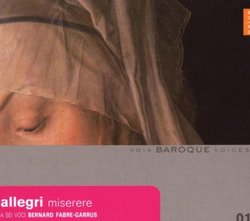Dark Secrets of the Vatican!
Giordano Bruno | Wherever I am, I am. | 10/19/2008
(5 out of 5 stars)
"Gregorio Allegri (1582-1652) surpassed himself in the composition of the "Miserere". He was a very fine composer, the successor to Palestrina and Nanino among the corps of singer/composers who made up the Pope's own chapel choir. His "Missa Vidi Turbam Magnam" - performed superbly on this CD - is a candidate in my estimation for the best post-Counterreformation liturgically acceptable mass, during the several centuries when the Catholic musical world was bifurcated between the "excesses" of the Baroque and the frozen purity of the Palestrina legacy. In other words, Allegri was the consummate musical conservative, writing 16th C polyphony for performance in the secret depths of the 17th C Vatican.
But as I said, the "Miserere" earned a distinction beyond anything else Allegri wrote. It was the private, closely guarded masterpiece of the Papal choir, performed only once a year, every year, during Holy Week in the Sistine Chapel. The very finest singers - including the castrati of the Vatican - sang the "Miserere" at the end of the Tenebrae service; while the Pope and cardinals knelt, the candles in the chapel were extinguished one by one. The singers were expected to improvise embellishments in the precise tradition of the Renaissance. By the end of the 18th C, when the child Mozart was one of the invited guests present at the Tenebrae, the skills of the Papal Choir were no longer sufficient for such improvisation, and a standard version of the Miserere was committed to paper, with embellishments concentrated in the soprano line, memorized by the castrati. That's the version of the Miserere which has been performed ever since, and recorded by various choirs in our times.
A Sei Voce performs the Miserere twice on this CD. The final track represents the late 17th C written version. The first track represents an effort to recreate the Miserere as it might have been sung in Allegri's own lifetime, with complex cadential ornamentation in all voices, not improvised but based on the research of Jean Lionner, a musicologist. Both versions are sung exquisitely, with women's voices taking the castrati roles. I imagine that some listeners will prefer the chaste simplicity of the later version. Myself, I find the ornamented reconstruction very interesting but perhaps a bit forced and formalized. I wonder whether the singers of A Sei Voci mightn't have done better to trust their own extempore skills at embellishment, in order to sound freely natural.
Those singers of A Sei Voci, by the way, can sing up a storm! They are good! A mixed chorus of women and men, they nonetheless produce a balanced and blended timbre, a spectrum of voices without an obvious break in color between the higher and lower voices. On the basis of this performance, I'd rank them with The Clerks' Group and the Binchois Consort at the apex of ensemble singing today. Bernard Fabre-Garrus, the director of the ensemble, deserves special accolades for his orotund yet flexible bass voice.
Easily a five-star performance."


 Track Listings (12) - Disc #1
Track Listings (12) - Disc #1